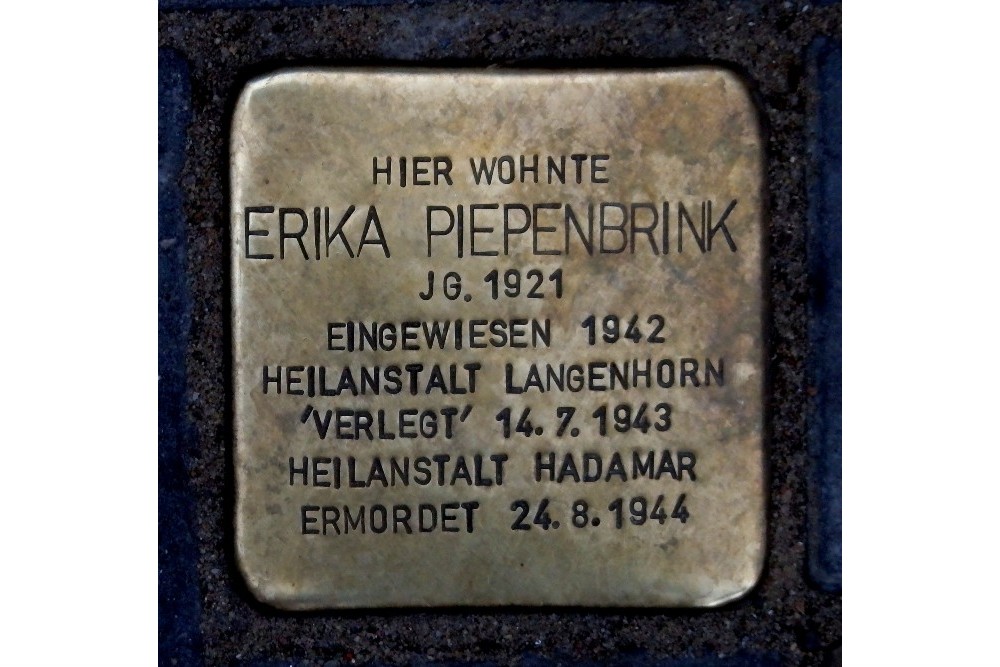Stumbling Stone Wilstorfer Straße 45
This small, brass, memorial plaque (Stolperstein or stumbling stone) commemorates:
* Erika Piepenbrink, born 1921, admitted 1942 Langenhorn Sanatorium, transferred 14 July 1943 Hadamar Sanatorium, murdered 24 August 1944.
* Bernhard Schreiber, born 1914, in the resistance / KPD, arrested 25 July 1934, Neumünster Penitentiary, 1942 "Punishment Battalion 999", fate unknown.
After leaving school, Erika Piepenbrink worked from 1937 to January 1942 in a variety of housekeeping and factory jobs, but she lost her jobs frequently because of her unusual behavior. In 1937 at age 16 she was involuntarily sterilized in the Harburg hospital. Five years later she was admitted to the Oberaltenallee Care Home, and in March 1942 she was transferred to Langenhorn, diagnosed as feeble-minded. Her parents were told she might be there for a year. However, in August the administration was acting to incapacitate her, telling her parents not to take on any obligations towards her. She was not allowed to leave for the Christmas holidays. And she was deemed to have an asocial illness. In July 1943 she was transferred to Hadamar State Hospital. In response to their inquiries, her parents were told that Erika was physically fine and should not be outside during wartime. An entry in the records for 23 August 1944 noted that Erika had pneumonia with high fever and a weak heart. She was dead the next day.
Hadamar is known for its killing center where 14,500 people with disabilities were murdered between January 1941 and March 1945. From August 1942 to the end, 4,500 patients – including Erika Piepenbrink -- were murdered by lethal injection, failure to treat an illness, or starvation.
Bernhard Schreiber joined the German Communist Party (KPD) as a young man. On 25 July 1934, he was arrested for his connection with illegal newspapers. Nine months later he was sentenced to 1½ years in prison. He served his time in the Neumünster Penitentiary. After returning to Harburg, he worked as a barber and married Bertha Schulz (born in 1903). Because of his imprisonment, he was not deemed suitable to serve in the military – until he was needed after the devastating winter battles in Russia. In 1942, he was drafted into the Probation Battalion 999 [Bewährungsbataillon 999] or – as on the stolperstein -- the Punishment Battalion 999 [ Strafbataillon 999]. He and the other convicted criminal soldiers were posted in particularly dangerous situations. In 1944, he did not return to his unit after a battle in the Greece-Albanian border area and was considered missing. In 1958, Bernhard Schreiber was declared dead.
"Stolpersteine" is an art project for Europe by Gunter Demnig to commemorate victims of National Socialism (Nazism). Stolpersteine (stumbling stones) are small, 10x10cm brass plaques placed in the pavement in front of the last voluntary residence of (mostly Jewish) victims who were murdered by the Nazis. Each plaque is engraved with the victim’s name, date of birth, and place (mostly a concentration camp) and date of death. By doing this, Gunter Demnig gives an individual memorial to each victim. One stone, one name, one person. He cites the Talmud: "A human being is forgotten only when his or her name is forgotten."
Do you have more information about this location? Inform us!
Source
Nearby
Museum
Point of interest
- Air Raid Shelter Phoenix-Viertel - Hamburg-Harburg
- Remains Dreifaltigkeits-Church - Hamburg-Harburg
- KZ Subcamp Dessauer Ufer - Hamburg-Kleiner Grasbrook
Monument
- War Memorial Harburg - Hamburg-Harburg
- War Memorial Harburg - Harburg
- Memorial Synagogue Harburg - Hamburg-Harburg
Remembrance Stone
- Stumbling Stones Wilstorfer Straße 43 - Hamburg-Harburg
- Stumbling Stones Rieckhoffstraße 8 - Hamburg-Harburg
- Stumbling Stones Rieckhoffstraße 1 - Hamburg-Harburg





